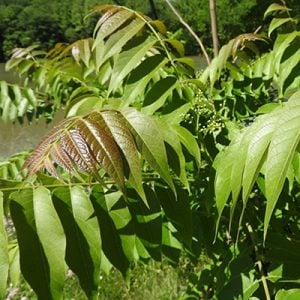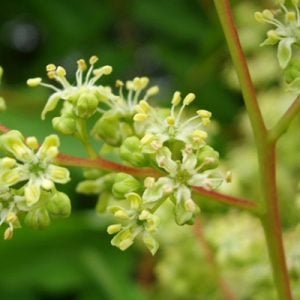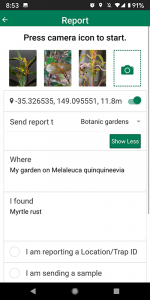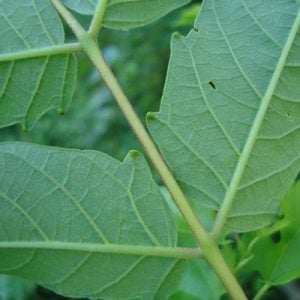Tree of heaven is not only a weed but also a significant host of spotted lantern fly, an exotic plant pest that could significantly impact our backyards, forests and plant industries.
Often looking for a pest can be difficult, so searching for and understanding the distribution of important host plants is used to support surveillance activities for plant pests and diseases.
That’s why we’re hosting the tree of heaven blitz. The information we collect will contribute to the mapping of tree of heaven which will help increase our preparedness for spotted lantern fly.
You can participate in the blitz by looking for tree of heaven in your backyard or local botanic gardens from 14-22 November 2020 and reporting your findings using the MyPestGuide™ Reporter app.
What is tree of heaven?
Tree of heaven (Ailanthus altissima) is an introduced species to Australia and is regarded an environmental weed in New South Wales, the Australian Capital Territory, Victoria, South Australia, Queensland and Western Australia.
This species primarily occurs in disturbed areas, but its winged seeds can blow considerable distances and it may also invade undisturbed habitats. It spreads into bushland from old homestead sites and other plantings, and is particularly invasive in gullies and vegetation on the banks of rivers. However, it can also invade forests and other woodlands.
It aggressively competes with other plants as it suppresses them with toxins and the abundant suckers (shoots) it produces from its shallow roots. Tree of heaven is also a very successful competitor for both light and nutrients, and typically shades out other species with its very large and dense leaves. It also re-sprouts vigorously when cut or damaged, making its eradication extremely difficult and time consuming.
How to identify tree of heaven
Tree of heaven is a deciduous tree or shrub that can grow up to 20 m high. It has greyish bark, cluster of small white or yellow-green flowers, and dark green leaves that turn yellow in autumn
Stem and leaves
The leaf-bearing, younger stems are smooth or pitted, speckled and reddish-brown in colour. Mature stems have grey or yellow-grey coloured bark that is slightly rough in texture.
This species has large compound leaves containing 13 to 40 individual leaflets. The leaflets are a narrow oval shape which tapper to a point at the end (ovate-lanceolate) and sit in opposite pairs along the main leaf vein. Each leaflet is 4-10 cm long and 1.5-6 cm wide, and has toothlike bumps at its base. These bumps are important for identifying tree of heaven.
Leaves turn yellow and fall off during the autumn. When new leaves emerge in the spring they are bronze coloured but quickly turn from medium to dark green as they grow.
Flowers and fruit
Tree of heaven is dioecious (has both male and female trees). Male trees are more conspicuous than female trees, as they produce three to four times more flowers. The male plants also release a foul-smelling odour while flowering to attract pollinating insects.
The flowers are small and appear in large clusters (up to 50 cm long) at the end of new shoots. They are white or greenish-yellow in colour with five small petals (2-4 mm long), and five tiny sepals (0.75-1 mm long).
Plants flower from 2 years old. Tree of heaven flowers in most states from November to January but has been reported to flower as late as autumn in western New South Wales. Fruit ripens about 3 months later and may remain on the tree over the following winter.
The fruit grows in clusters which may contain hundreds of seeds. The fruit consist of a rounded disc containing the seed (3-4 mm across) and a large flat wing (3-5 cm long and 7-15 mm wide). These ‘winged’ fruit (samara) are initially yellow or greenish in colour but turn reddish-pink or reddish-brown as they mature. The whole cluster rarely falls to the ground. When ready, individual samaras or samaras in smaller groupings fall to the ground with the help of gravity and/or the wind.
Similar species
Tree of heaven can sometimes be confused with rhus (Toxicodendron succedaneum) but they can be told apart by two key differences. Firstly, tree of heaven leaves turn yellow in colour before they are shed while rhus leaves turn a bright reddish colour. Secondly, the samaras of tree of heaven are relatively large (3-5 cm long) and turn a reddish colour as they mature. In contrast, the somewhat rounded berry-like fruit of the rhus are relatively small (5-10 mm across) and turn dark-brown as they mature.
Two native trees, red cedar (Toona ciliata) and pencil cedar (Polyscias murrayi), are also easily confused with tree of heaven as they have very similar leaves. However, neither of these native trees have glands on the base of their leaflets, and pencil cedar does not lose its leaves during autumn (it is evergreen). Their fruit are also different. The fruit of red cedar is a dry capsule (1-2 cm long) which splits open to release four or five winged seeds and the fruit of pencil cedar is a small purple ‘berry’ about 4 mm across.

Tree of heaven has large compound leaves made up of individual leaflets. Image: Karan A. Rawlins, University of Georgia, Bugwood.org

When new tree of heaven leaves emerge in the spring they are bronze coloured but quickly turn from medium to dark green as they grow. Image: Richard Gardner, Bugwood.org

Tree of heaven flowers are small and greenish-yellow in colour. They grow in large clusters at the end of new shoots. Image: Jan Samanek, Phytosanitary Administration, Bugwood.org
How to get involved
From 14-22 November 2020, look for tree of heaven in your backyard, local roadsides, reserves or botanic gardens. Send reports of suspected tree of heaven plants to the ‘botanic gardens’ project in the MyPestGuide™ Reporter app.
To make a report:
- Download the MyPestGuide™ Reporter app or head to the website to use the online MyPestGuide™ Reporter tool.
- Take a photo of the plant.
- Turn on location.
- Select ‘Botanic gardens’ in the ‘Send report to’ field (click ‘Show More’ if it is not visible).
- Report the location you looked for tree of heaven in the ‘Where’ field.
- Report the presence of tree of heaven and provide a description in the ‘I found’ field.
- Press ‘Continue’ to submit your report.

 If you find an unusual plant pest or disease outside of the Botanic Gardens Biosecurity Network surveillance blitzes, please report it though MyPestGuide™ Reporter or call the Exotic Plant Pest Hotline (1800 084 881).
If you find an unusual plant pest or disease outside of the Botanic Gardens Biosecurity Network surveillance blitzes, please report it though MyPestGuide™ Reporter or call the Exotic Plant Pest Hotline (1800 084 881).
To learn more about making a report though MyPestGuide™ Reporter check out this article.
For a summary of how to participate in the tree of heaven blitz download this flyer.
The WeedsAustralia profile for tree of heaven provides information about management options for this weed.




